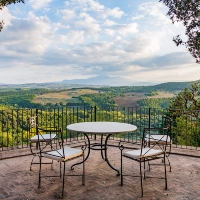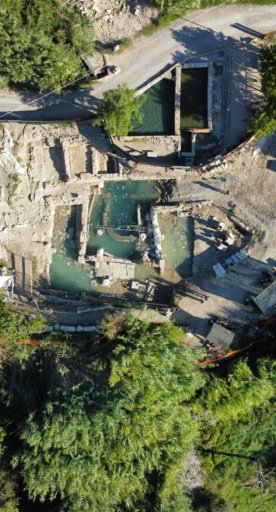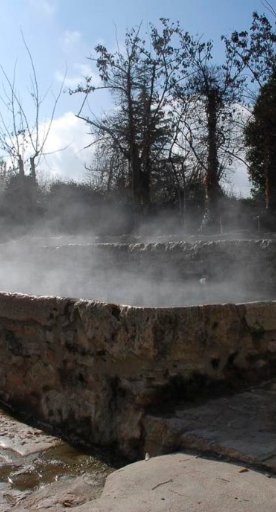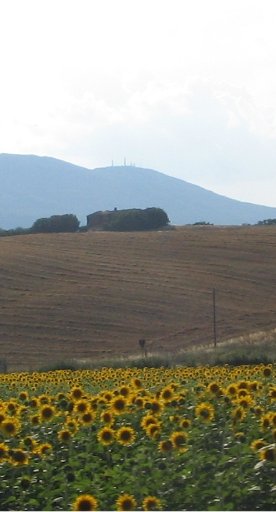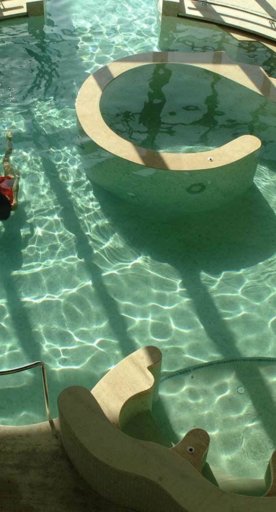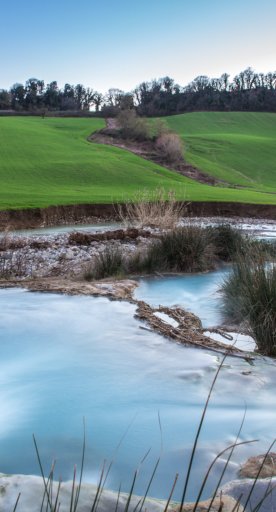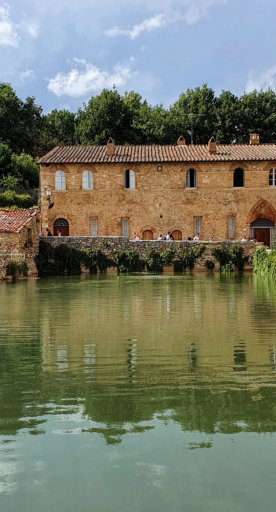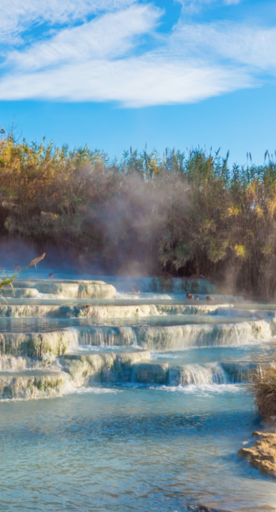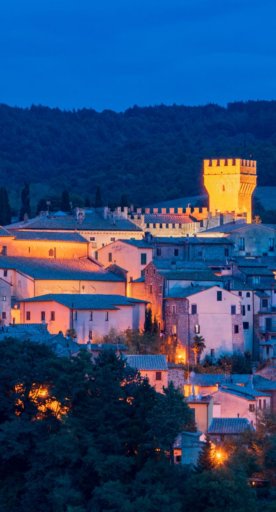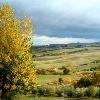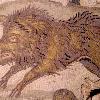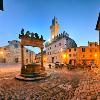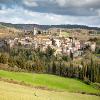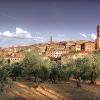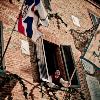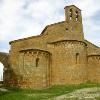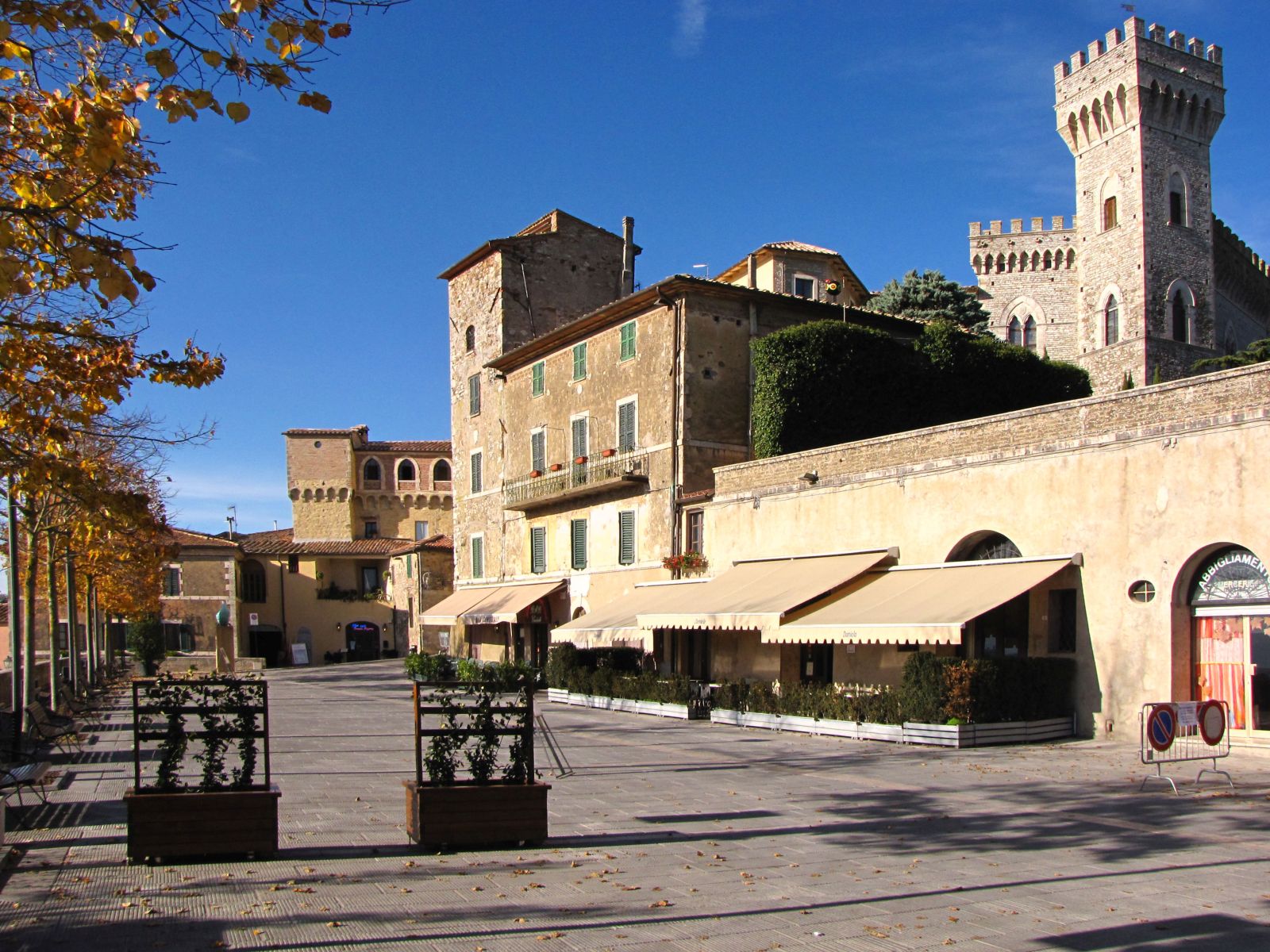San Casciano dei Bagni
Between famous thermal springs and the enchantment of the Tuscan countryside
San Casciano dei Bagni has always been a renowned spa village, characterized by the presence of numerous springs of sulphurous waters spread throughout its territory.
The Etruscans were the first to build structures for thermal waters, however, it was under the domination of the Romans, true devotees of thermal baths, that the healing properties of these waters gained their huge appeal, as evidenced by the presence of numerous archaeological finds in the area.
Over the centuries, the thermal baths have continued to attract visitors from all over Europe, attracted by the possibility of solving their ailments thanks to the properties of the waters of San Casciano.
What to see in San Casciano dei Bagni
The thermal baths have attracted visitors for centuries. People from all over Europe trusted the waters to treat all types of ailments, and the steady presence of international, upper-class visitors enhanced San Casciano architecturally: it is thanks to these visitors of the past that the buildings’ facades vaunt remarkably sculpted decorations. In 1607, Grand Duke Ferdinand I had a portico built at the source of the Ficoncella spring – to get an idea of the water’s worldly fame.
Among the most important places of worship to visit in the village is the Insigne Collegiata di San Leonardo, whose structure and appearance have been modified several times over the centuries.
Other buildings worth visiting are the Church of Sant'Antonio, the early Christian church of Santa Maria della Colonna, built on the remains of a pagan temple, and finally the Church of San Michele Arcangelo that's perhaps the most fascinating monument in the town.
In the historic center you can find the 16th century Palazzo dell'Arcipretura and the Palazzo Comunale, located at the highest point of the village and that was once part of the defensive system of the city, as evidenced by the thickness of the external mountain.
The thermal baths have attracted visitors for centuries. People from all over Europe trusted the waters to treat all types of ailments, and the steady presence of international, upper-class visitors enhanced San Casciano architecturally: it is thanks to these visitors of the past that the buildings’ facades vaunt remarkably sculpted decorations. In 1607, Grand Duke Ferdinand I had a portico built at the source of the Ficoncella spring – to get an idea of the water’s worldly fame.
Among the most important places of worship to visit in the village is the Insigne Collegiata di San Leonardo, whose structure and appearance have been modified several times over the centuries.
Other buildings worth visiting are the Church of Sant'Antonio, the early Christian church of Santa Maria della Colonna, built on the remains of a pagan temple, and finally the Church of San Michele Arcangelo that's perhaps the most fascinating monument in the town.
In the historic center you can find the 16th century Palazzo dell'Arcipretura and the Palazzo Comunale, located at the highest point of the village and that was once part of the defensive system of the city, as evidenced by the thickness of the external mountain.
Nearby
Fonteverde is just a few minutes from San Casciano dei Bagni. The elegant spa and 5-star resort overlooks ravines and green hills. Formed from a Medici portico built in the 17th century by Grand Duke Ferdinando I de 'Medici, it has thermal pools fed by natural springs that rich in therapetuci properties, reaching a surface temperature of 42°C.
In the subsoil of the famous thermal waters, one of the most precious archaeological treasures of recent times was discovered in 2019: a large sanctuary complex from the Roman and even earlier Etruscan eras, characterized by a quadrangular building with a large travertine pool. Just a short distance from the village, the excavations revealed dozens of bronze votive statues, some nearly 40 inches (100 centimeters) high, in perfect condition. So exceptional is the find that it is considered the most important in Italy after the Riace Bronzes. Today, you can visit the archaeological site in the company of the experts who unearthed the Rediscovered Sanctuary.
San Casciano dei Bagni is immersed in the colors of the Valdichiana Senese, a countryside that's rich in vineyards and olive groves, sites of artistic interest and charming villages. It's the perfect starting point for discovering one of the most well-known and charming areas of Tuscany.
To the north-west of San Casciano, you'll find the village of Celle di Rigo, whose name potentially derives from "sacred cells" or "wine cells", referring to the caves located below the town that are now used as cellars. Due to its strategic position, this small hamlet has been an important military and trading post over the centuries. In the upper part of the town, you can spot the Torre di Celle, the last remnant of the historic castle keep.
Mount Cetona rises to separate the Valdichiana from the Val d’Orcia. At the beginning of the century, the first archaeological research was carried, with the many finds now on display at the Civic Museum for Prehistory of Monte Cetona and the Archaeological Naturalistic Park, where you can also visit the caves that were inhabited in Prehistory, and in subsequent eras by saints and hermits.
Monte Cetona is the ideal place for those who love hiking or biking. From the peak, you can admire a spectacular view of the Val d'Orcia and Monte Amiata on one side, and from Valdichiana up to Perugia on the other.
Fonteverde is just a few minutes from San Casciano dei Bagni. The elegant spa and 5-star resort overlooks ravines and green hills. Formed from a Medici portico built in the 17th century by Grand Duke Ferdinando I de 'Medici, it has thermal pools fed by natural springs that rich in therapetuci properties, reaching a surface temperature of 42°C.
In the subsoil of the famous thermal waters, one of the most precious archaeological treasures of recent times was discovered in 2019: a large sanctuary complex from the Roman and even earlier Etruscan eras, characterized by a quadrangular building with a large travertine pool. Just a short distance from the village, the excavations revealed dozens of bronze votive statues, some nearly 40 inches (100 centimeters) high, in perfect condition. So exceptional is the find that it is considered the most important in Italy after the Riace Bronzes. Today, you can visit the archaeological site in the company of the experts who unearthed the Rediscovered Sanctuary.
San Casciano dei Bagni is immersed in the colors of the Valdichiana Senese, a countryside that's rich in vineyards and olive groves, sites of artistic interest and charming villages. It's the perfect starting point for discovering one of the most well-known and charming areas of Tuscany.
To the north-west of San Casciano, you'll find the village of Celle di Rigo, whose name potentially derives from "sacred cells" or "wine cells", referring to the caves located below the town that are now used as cellars. Due to its strategic position, this small hamlet has been an important military and trading post over the centuries. In the upper part of the town, you can spot the Torre di Celle, the last remnant of the historic castle keep.
Mount Cetona rises to separate the Valdichiana from the Val d’Orcia. At the beginning of the century, the first archaeological research was carried, with the many finds now on display at the Civic Museum for Prehistory of Monte Cetona and the Archaeological Naturalistic Park, where you can also visit the caves that were inhabited in Prehistory, and in subsequent eras by saints and hermits.
Monte Cetona is the ideal place for those who love hiking or biking. From the peak, you can admire a spectacular view of the Val d'Orcia and Monte Amiata on one side, and from Valdichiana up to Perugia on the other.
Events
Every May, the small hamlet of Celle sul Rigo hosts the Sagra dei Pici, the oldest festival dedicated to this Sienese specialty. Stands are set up on the streets of the town where you can taste pici, with live demonstrations of both the kneading and how it's prepared, allowing the tradition to be passed on from generation to generation.
Every May, the small hamlet of Celle sul Rigo hosts the Sagra dei Pici, the oldest festival dedicated to this Sienese specialty. Stands are set up on the streets of the town where you can taste pici, with live demonstrations of both the kneading and how it's prepared, allowing the tradition to be passed on from generation to generation.
Typical dishes and products
Here, the previously mentioned pici are traditionally seasoned with garlic, a simple and tasty sauce that uses a variety of local garlic that are large in size and have a mild flavor.
The whole area of San Casciano is known for high quality products, such as DOP Terre di Siena extra virgin olive oil, truffles, the breeding of Chianina oxen and Cinta Senese DOP, a local variety of pig raised in the woods on small family farms.
San Casciano dei Bagni is also part of the Orcia Wine Trail and the Nobile di Montepulciano Wine and Valdichiana Senese Taste Trail that bring together some of the most characteristic villages of Tuscany, united by naturalistic, historical and food and wine attractions.
Here, the previously mentioned pici are traditionally seasoned with garlic, a simple and tasty sauce that uses a variety of local garlic that are large in size and have a mild flavor.
The whole area of San Casciano is known for high quality products, such as DOP Terre di Siena extra virgin olive oil, truffles, the breeding of Chianina oxen and Cinta Senese DOP, a local variety of pig raised in the woods on small family farms.
San Casciano dei Bagni is also part of the Orcia Wine Trail and the Nobile di Montepulciano Wine and Valdichiana Senese Taste Trail that bring together some of the most characteristic villages of Tuscany, united by naturalistic, historical and food and wine attractions.
What’s nearby?
Valdichiana Senese
